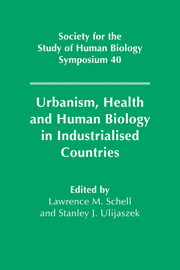Book contents
- Frontmatter
- Contents
- List of contributors
- Part I The urban environment
- Part II Epidemiology
- Part III Poverty and health
- Part IV Behavior and stress
- 12 Urbanism and psychosocial stress
- 13 Physical activity, lifestyle and health of urban populations
- 14 HIV transmission in urban environments: London and beyond
- Part V The future
- Index
13 - Physical activity, lifestyle and health of urban populations
Published online by Cambridge University Press: 06 January 2010
- Frontmatter
- Contents
- List of contributors
- Part I The urban environment
- Part II Epidemiology
- Part III Poverty and health
- Part IV Behavior and stress
- 12 Urbanism and psychosocial stress
- 13 Physical activity, lifestyle and health of urban populations
- 14 HIV transmission in urban environments: London and beyond
- Part V The future
- Index
Summary
Editors' introduction
Ways in which physical activity is influenced by social, cultural, economic and geographical factors in urban settings are discussed in this chapter. Urban populations and the environments they inhabit are highly diverse, this being largely related to position in the economic status system, and reflected in energy expenditure levels. Among urban populations, other factors become increasingly important as the need to work physically hard diminishes with the mechanisation of labor, and the increasing proportion of sedentary paid work. These can be disaggregated into those that operate in nested fashion at the individual, household, neighbourhood and institutional levels. Cultural and demographic factors may have an underlying effect on the way in which the interplay between these factors varies from place to place, although institutional influences may be quite idiosyncratic, and vary enormously within any sociocultural and geographic region. Thus far, there is little data from urban populations on human energetics in an ecological context, and there is a great need to study urban compexity in relation to physical activity. Energetics and physical activity are important to understand in relation to the increasing global prevalence of overweight and obesity (which has taken place predominantly among urban populations), and with respect to ovarian function, which Ellison, in chapter 6, indicates may be influenced by many factors in the urban environment.
- Type
- Chapter
- Information
- Urbanism, Health and Human Biology in Industrialised Countries , pp. 250 - 279Publisher: Cambridge University PressPrint publication year: 1999
- 5
- Cited by



